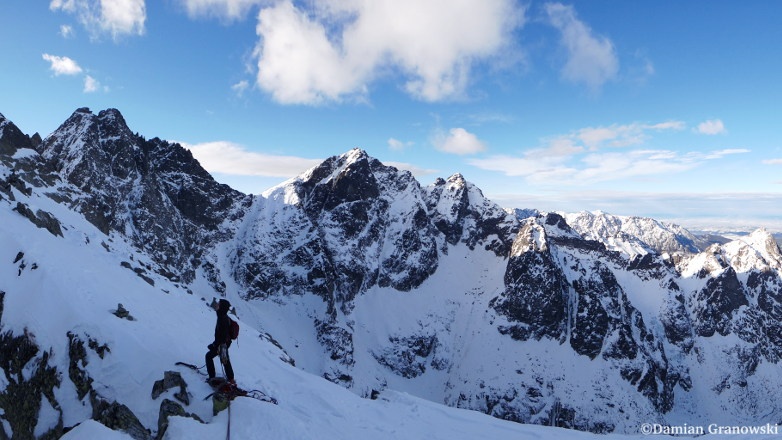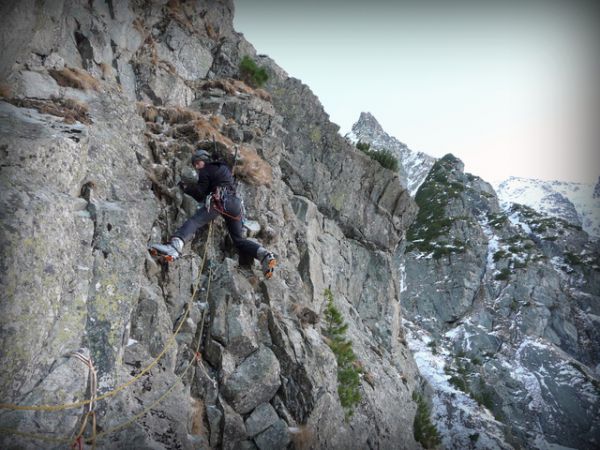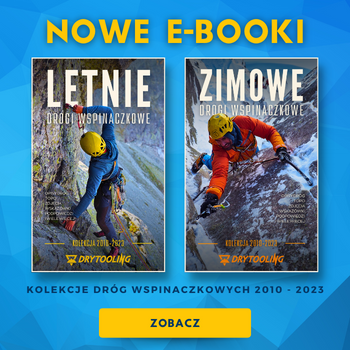The Tatra Mountains are located between Poland and Slovakia. They are the smallest Alpine range in Europe, with their highest peak Gerlachovský štít reaching only 2655 m above sea-level. They offer a lot of exciting rock climbing opportunities in summertime, yet wintertime can offer even better climbing options. The heights of walls reach up to 900 meters, about 200 - 300 meters on average. Their altitude is usually 1800-2300 m, so you don't need acclimatization.
The foothills around Zakopane consist of grassy Alpine meadows, with a distinct highland flora. The High Tatras are rocky and wild. Everything is there: from easy scrambles and ridge walks such as the renowned Orla Perć (Eagle's Path) via ferrata, to multi-pitch rock routes at all difficulty grades.
In this article I am going to write about multi-pitch climbing on the Polish side of the Tatras mostly, accommodation and a lot of other stuff you can enjoy while mountaineering in this amazing region. If you want read about rock climbing in Poland, check this article: Rock climbing in Poland.
I'm originally from Poland therefore I have better knowledge about climbing in Polish Tatras than I have about Slovakian side.

Jacek Kierzkowski on Direttissima of Mięguszowiecki Szczyt Wielki . Fot. dg
How to get there?
Polish Tatras
To get there you can fly to Kraków, and from there you have only about 110 km left to get to Zakopane. There is plenty of buses to choose from, departing from Krakow main bus station and arriving in Zakopane. Once you get there, the local transport companies can take you to the surrounding valleys (Morskie Oko, Hala Gąsienicowa) or to Slovakia. With easy communication from Kraków to Zakopane, it is entirely possible to organise a “long climbing weekend” in the Tatras.
Slovak Tatras
![]() The best option is to reach Tatras from Poprad - 5 hours by train from Bratislava, 8 hours from Prague and 10 from Budapest.
The best option is to reach Tatras from Poprad - 5 hours by train from Bratislava, 8 hours from Prague and 10 from Budapest.
From Poprad take one of the electric trains to Stary Smokovec or another resort. If you want to start from Strbske Pleso this takes 1.5 hours though.

Marcin Gąsienica-Kotelnicki on Mnich. Photo: Adam Kokot
Accomodation
While in Poland, you can stay in Zakopane, with lots of private rooms, hostels (rather cheap) and a few campsites on offer. Being a very popular touristic destination, Zakopane is in its peak season during holiday periods and winter weekends so if you want to avoid the crowds there are also lodging options in the surrounding villages (Bukovina, Bialka Tatrzanska, Kościelisko). Note that you will have a long way to walk from Zakopane to climbing walls. A good idea is to stay in a mountain hut then. Mountaineering Huts provide food and beverage and you can also rent a bed (during summer and winter seasons they are usually overcrowded, but you can sleep on the floor). From any of those huts, you have only 1-2 hours walk to start climbing. In Slovakia, it is similar but sometimes the walks may take longer.

Climbing on Maly Osarpanec, Zlomiska Zatoka. Photo Mateusz Kosakowski
Refuges:
Morskie Oko
“Murowaniec” (Hala Gąsienicowa)
Pięć Stawów
Chata pri Zelenom Plese (Kiezmarska Valley)
Skalnata Chata (Skalnata Valley)
Teryho Chata (Valley Piatich Spisskych Plies)
Zbojnicka chata (Velka Studena Valley)
Chata Popradske Pleso (Mengusovska Valley)
Chata pod Rysmi (Zabia Valley)
W Samo Poludnie (Bula pod Bandziochem). Photo. Cezary Klus
Maps and trails?
Maps are easily available in many shops in Zakopane. Online maps are accessible at the following addresses:
High Tatras (Slovak: Vysoké Tatry, Polish: Tatry Wysokie)
Western Tatras (Západné Tatry, Tatry Zachodnie)
The Slovak 1/50.000 Vysoké Tatry map (nr. 113) is a very good map.
Throughout the Tatras, trails and paths are signed with coloured markers, and there are lots of wooden arrows to show the way on most crossings. You shouldn’t get lost as long as you have a map and stick to the trails, however in towns you do sometimes have to look a bit for where the trails start.
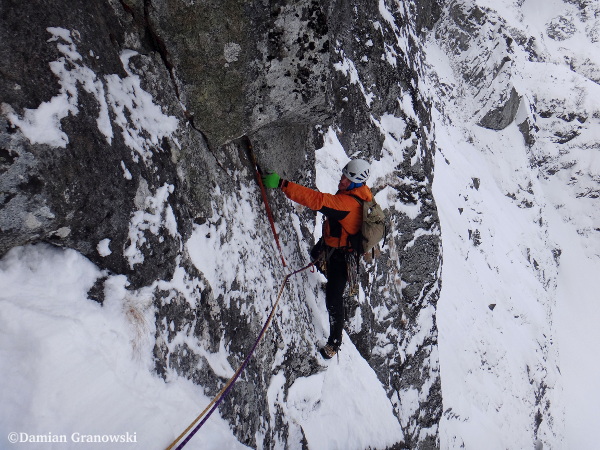
Michal Dorocicz on Starek-Uchmanski. Photo. dg
Where you can climb in Tatras?
Climbing in the Tatras is allowed only in the designated regions in the High Tatras. In Poland, all the climbers must provide detailed written information about their planned climbing excursion in the Book of the Climbers’ Departures (Księga Wyjść Taternickich). These can be found in shelters.
Designated regions:
-
Morskie Oko area: the region from Bialczańska Saddle (Białczańska Przełęcz), Rysy, Mięguszowieckie Peaks (Mięguszowieckie Szczyty), Cubryna to Chałubiński Gateway (Wrota Chałubińskiego) and the Monk (Mnich)
-
Five Ponds Valley (Dolina Pięciu Stawów) and Beech Forest Valley (Buczynowa Dolina) area: from the top of Świnica to the Zawrat Saddle (Przełęcz Zawrat) between the ridge and the red marked tourist track and in the region of the ridge and the below walls from the Przełęcz Zawrat to the Mała Buczynowa Przełączka
-
Hala Gąsienicowa: in the region of the ridge and below walls from Żółta Przełęcz, through Granaty, Kozi Wierch, Zawratowa Turnia, Świnica to Świnicka Przełęcz, with the side ridge of Kościelec to Karb
marked up on the western wall of the rock gate at the entrance to Dolina Lejowa -
marked up on the rock in the Jaroniec.

Climbing on Kutta Route (Batyzowiecki Peak). Fot. Julita Chudko
On Slovakia you must be associated in Mountaineering Club. Here you have link to restriction. If you want climb you must operate on routes on III UIAA grade. Be prepared than on Slovakia trails are officially closed from the first of November to 15 June.
In Slovakia you must have the insurance, as you must pay for mountain rescue if needed. In Poland the Mountain Rescue services are rendered free of charge (TOPR).
Camping on the face is allowed only in extreme, life-threatening situations.
Character of climbing

Guide with client, on Grań Kościelców. Photo: Adam Kokot
Summer
The typical climbing routes in Tatra have grades between IV and VI UIAA and to get the most out of the area you should be comfortably climbing at VI UIAA level on OS.
The High Tatras rock type is granotodioryte (almost like granite). There are lots of corners, cracks, chimneys, slabs, small roofs and other typical mountains formations. Usually, the fricktion is very decent.
Similar to granite, there are no pockets, only typical small edges, crimps, side clings and cracks.
Winter
During this time, you will find alpine terrain covered with snow, ice, rock and... frozen grass. Lots of routes in Poland are quite difficult during the summer season due to presence of grass and loose rock, but during the winter... YES… the grass patches freeze over and you can stick your ice tool in this, like in ice :-). Sometimes there is only grass and you must climb in this like in ice (protection from warthogs and ice pitons). Getting scared? Don’t be frozen, overhanging grass is mainly found on easy pitches. The harder pitches are usually rock.
If climbing conditions are good, then you have consolidated snow, frozen grass, lots of alpine ice and sub zero temperatures.


View from Galeria Gankowa. Photo. Damian Granowski
Grades
In Tatras, “tatrzanska” scale is employed, basically the same as UIAA grade. In winter, Slovaks use M grade for mixt. In Poland, we use the M scale sometimes, but we have also our original winter grade. We write grade in Arabic numerals. It’s harder about half of degree than mixt scale. For example, if you have 6+, then it will translate to M6. Here you have link about tatrzanska scale.
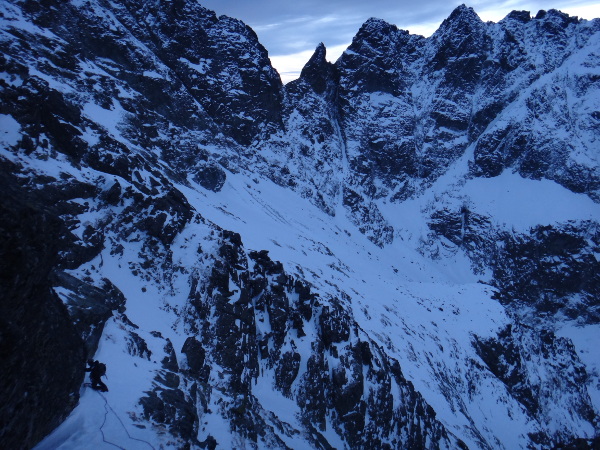
Descent from Nizne Rysy. Photo. Damian Granowski
Protection
Whilst climbing, it is forbidden to install or uninstall permanent protective elements without the permission from the Tatra National Park authorities. The majority of climbing routes have to be completed on your own protection, you can find plenty of pitons and sometimes some bolts on most of them.
On most popular walls, you will sometimes find prepared belays (like on Mnich, Osterva), but usually you must build them yourself.
Below is the list of some of the hardest sport routes (up VII to X UIAA grade).

Tadek Grzegorzewski on ice climbing on Sniezna Dolina. Photo Damian Granowski
Typical set of gear on most routes is like that:
Summer:
Half rope 2x 50-60 m
Set of nuts
7-10 cams (to #C2)
2-3 micro-cams (on serious climbing (like Kazalnica))
10-12 quickdraws (the most of them are mountain quickdraw)
4-6 loops (120 cm. Dynema with carabiner)
2 loops (not dynema) to build belays
Pitons (on serious routes)
2x angle piton 50mm
2x knife blade 40 mm
1 x beak
Hammer

Climbing on Mnich. Photo. Magdalena Dudek
WINTER
Half rope 2x 50-60 m
Set of nuts + 2-4 Tricams
7-10 friends (to #C2)
2-3 microfriends
10-12 quickdraws (the most of them are mountain quickdraw)
4 loops (120 cm. Dynema with carabiner)
2 loops (not dynema) to build belays
Pitons (always!)
- 2x angle piton 50mm
- 2x knife blade 40mm
- 2x beak
- 1x Lost arrow Piton
- 1x Ice Piton
- 1x Warthog) (or another Ice Piton)
Hammer
Technical Crampons. Better with monopoint in mixt. On frozen grass and Ice better will be duopoint
Ice Axes (Petzl Nomic, BD Fusion, DMM Swith) with pics to mixt.

NE Pillar of Ganek. Recommended route, The wall has about 850 m denivelation. Fot. Maciej Chmielecki
When is the best time to climb in Tatras?
You can climb all year round in the Tatras. However there is no guaranteed period of stable weather conditions. You must therefore be prepared for unexpected spells of bad weather. Good luck is what you need as it is not possible to correctly predict when the weather will be good enough.
Maciej Chmielecki on descent from NE Peak of Swinica. Photo Damian Granowski
Summer season (mid of May to mid of October)
Summer season starts about mid of May, when you can usually go rock climbing on walls with S, SE and SW exposures. In June, the temperature increases but there still can be some snow on couloirs and shaded walls can be wet. June to end of July is the season of afternoon’s storms - be prepared to depart early when the sky is still clear. From the end of July to the end of September the weather should be reasonably stable (however there is still small chance of storms). September is the month with the lowest number of rainy days.
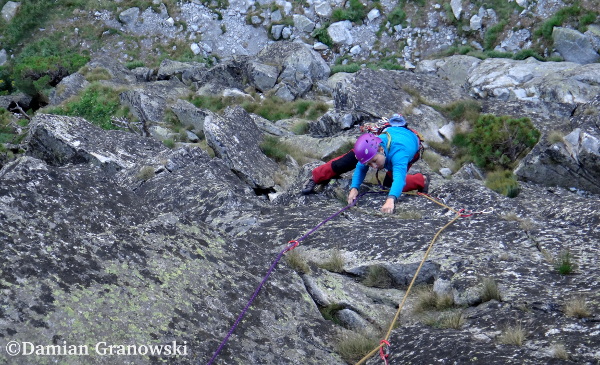
Anita Słowicka on Dieska Route. Photo. Damian Granowski
In June, July and August the temperatures can vary from 0 to 30 °C. A lot of climbs are at altitudes of 2000 metres above sea level or more. It shouldn’t come as a surprise that while it’s 30 °C in Zakopane the peak of Mnich will be 20 °C. The weather can change quickly and it snowfalls in June or July are not unheard of.
You can climb also in November and October, but then probably climbing will be possible only on the walls with S, SE and SW exposures
Winter season (Mid of November to mid of March)

View from point, below peak of Gerlach, Stanislawski Route. Fot. dg
Sometimes in mid-November you can climb with use of ice tools and crampons. Probably there will be very little snow, but routes with grass/ice should be frozen. An even better time will be mid-December when there is more snow, the temperature is lower and you probably will have pleasant conditions, however the days are short.
Sometimes you may experience Halny, a strong and hot southerly wind, similar to Foehn in the Alps. Although the temperature increases, typically it will bring bad weather.
Weather forecoast and webcams you will find there: Weather for Tatras (PL).
Other activities
Sport rock climbing – There is some limestone spots near of Tatras. On Podhale (near of Zakopane) you have Jaroniec, Przelom Bialki and... Cracow area offers lots of limestone rock climbing possibilities. Check this article: Rock climbing in Poland.
In Slovakia, there is Tatranska Kotlina.
Dry-tooling – during winter time you may go visit Wdzar quarry near Zakopane and some other spots (check with local climbers). In Slovakian Tatras, there is Tatranska Kotlina, Vecny dazd, and Sektor Bartka.
Caving in Tatras – There are some caves in Tatras, however I am not sure about the access for foreign climbers. Some useful information can be found there.
Trekking/hiking in Tatras – With hundreds of kilometres of trails in Tatra, you won't get bored. You can also visit other mountains near the Tatras, like Pieniny, Gorce and Veľká Fatra.
Ski-tour – Tatras have some very good spots for skiing (here you have some propositions). Be aware that there can be risk of avalanches. If the weather is not in your favour then I would suggest going to other mountains in Poland (Gorce, Pieniny, Babia Gora) and Slovakia (Veľká Fatra ...).
The best ski-tour guidebook is "Tatry. Przewodnik Skiturowy" (by Wojciech Szatkowski).
Skis – there are lots of ski lifts in Poland (Bialka Tatrzanska, Kasprowy Wierch) and Slovakia (better infrastructure. Hopok, Tatranska Lomnica).
Thermal pools – You will find thermal pools and spas in the Tatra region, like the ones in Szaflary, Bialka Tatrzanska, Bukowina Tatrzanska, Tatralandia.
Rafting on Dunajec – Scenic rafting (aboard wooden rafts) on Dunajec River in Pieniny is an ideal family oriented activity.

Damian Granowski on Miedzymiastowa, Mnich. Photo Anita Słowicka
Best walls to climb in Tatras
Recommended peaks in Tatras
Batyżowiecki Szczyt
Durny Szczyt
Ganek
Gerlachovsky stit
Giewont
Kazalnica Mięguszowiecka
Kezmarsky stit (Kieżmarski Szczyt)
Kołowy Szczyt
Kościelec
Jastrabia veza (Jastrzębia Turnia)
Jaworowy Szczyt
Ľadova kopa
Ľadovy stit (Lodowy Szczyt)
Lomnicky stit (Łomnica)
Mała Śnieżna Turnia
Maly Kezmarsky Stit (Mały Kieżmarski Szczyt)
Maly Lodovy Stit
Mnich
Nizne Rysy
Swinica (Świnica)
Mieguszowiecki Szczyt Wielki (Mięguszowieckie Szczyty)
Vysoka (Wysoka)
Żabi Koń
Zadni Mnich
Gallery from some of this peaks on drytooling.com.pl.
Recommended climbing routes in Tatras

Michał Król on Pulp Fiction IX-, Kościelec. Fot. Adam Kokot
Here is my talk about classic winter routes in Tatras (from M5+ to M7)
Guidebooks:
Paryski, Witold Henryk: Tatry Wysokie Przewodnik taternicki. (25 tom of climbing in High Tatras)
Puskas, Arn: Vysoke Tatry, monografia I-X (10 toms of climbing in High Tatras)
Taternik (officially magazine of PZA)
Grzegorz Głazek: Mastertopo posters
Marian Bobovcak, Marian Jacina: Vyber Tatranskych Stien, volume I and II
E-books with summer and winter climbs in Tatras from blog drytooling.com.pl.
Internet:
drytooling.com.pl – My polish website about winter climbing and alpine. But also you will find lot of topo of climbing routes in Tatra, especially Polish. Here is link to list of routes in Tatra and here you will find list of peaks.
climber.com.pl - Nice blog with lot of climbing routes descriptions.
google.pl – YES, You Can ;)
goryonline.com – website of GORY polish climbing magazine. There will be lot of materials about Tatras.
james.sk – Slovakian climbing website
lezec.cz - Czech climbing website
supertopo.pl – Small site with topo (very good) of “the most beautiful climbing routes in Tatra”
taternik.net – Very nice site with photo topo of walls in Tatra Mountains. Recomended.
tatry.nfo.sk – The best climbing website about climbing in Tatras (Slovakia side). Lot of photo-topo, and routes. Very recommended if you want climb in Slovakia Tatras.
wspinanie.pl – Some nice topos and forum about climbing in Tatras.
Here you have Polish-english climbing dictionary.
Weather forecoast and webcams you will find there: Weather for Tatras (PL).
Also you can phone to me, to ask question about climbing in Tatras. My phone number: +48 794-010-870. I'm also climbing instructor and my offer you will find here: Climbing Courses in Poland.
You can also like my FB page ;)
Many thanks for Natasza Przybylska for proofreading!

